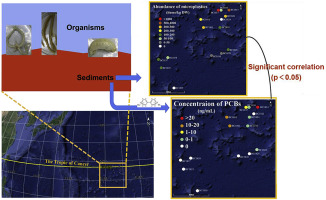Environmental Pollution ( IF 7.6 ) Pub Date : 2020-01-10 , DOI: 10.1016/j.envpol.2020.113948 Dongdong Zhang 1 , Xidan Liu 1 , Wei Huang 2 , Jingjing Li 1 , Chunsheng Wang 3 , Dongsheng Zhang 3 , Chunfang Zhang 1

|
Microplastics are ubiquitous in marine environments. Sediments and marine organisms are recognized as the carriers and final destinations of microplastics. However, research on the concentration and abundance of microplastics in deep-sea sediments and organisms is limited. In this study, samples of sediments and organisms were collected from deep-sea locations of the western Pacific Ocean, with the depth ranging from 4601 m to 5732 m. Microplastics were extracted from the samples and analyzed by micro-Fourier-transform infrared spectroscopy. The average abundance of microplastics in the sediments was 240 items per kg dry weight of sediment. The microplastics were predominantly fibrous in shape (52.5%), blue in color (45.0%), and less than 1 mm in size (90.0%). The most commonly detected polymers were poly(propylene-ethylene) copolymer (40.0%) and polyethylene terephthalate (27.5%). The concentrations of polychlorinated biphenyls (PCBs), which are representatives of persistent organic pollutants, in the pore water of sediment samples were also investigated. A significant correlation between the distribution of microplastics and the PCB concentrations in sediments was found (P = 0.016). Microplastics were also detected in deep-sea organisms (i.e., Crinoidea, Pheronematidae, Ophiuroidea, and Gammaridea) in the sampling region, with an abundance of 0–3 items per individual biological sample. This assessment of microplastics in deep-sea sediments and benthic organisms of the western Pacific Ocean confirms that microplastic pollution exists in the deep-sea ecosystems of this region.
中文翻译:

西太平洋深海沉积物和生物中的微塑性污染。
微塑料在海洋环境中无处不在。沉积物和海洋生物被认为是微塑料的载体和最终目的地。但是,对深海沉积物和生物中的微塑料的浓度和丰度的研究是有限的。在这项研究中,沉积物和生物样本是从西太平洋深海位置收集的,深度范围为4601 m至5732 m。从样品中提取微塑料并通过微傅立叶变换红外光谱法进行分析。沉积物中微塑料的平均丰度为每千克沉积物干重240个项目。微塑料的形状主要为纤维状(52.5%),蓝色为彩色(45.0%),尺寸小于1毫米(90.0%)。最常见的聚合物是聚(丙烯-乙烯)共聚物(40。0%)和聚对苯二甲酸乙二酯(27.5%)。还研究了沉积物样品孔隙水中代表持久性有机污染物的多氯联苯(PCBs)的浓度。发现沉积物中的微塑料分布与PCB中的浓度之间存在显着的相关性(P = 0.016)。在采样区域的深海生物(即,Cri科,披甲科,蛇皮科和伽马科)中也检测到了微塑料,每个单独的生物样品中有0–3项。对西太平洋深海沉积物和底栖生物中的微塑料的评估证实,该地区的深海生态系统中存在微塑料污染。











































 京公网安备 11010802027423号
京公网安备 11010802027423号